The latest views of Ceres’ enigmatic white spots are sharper and clearer, but it’s obvious that Dawn will have to descend much lower before we’ll see crucial details hidden in this overexposed splatter of white dots. Still, there are hints of interesting things going on here.
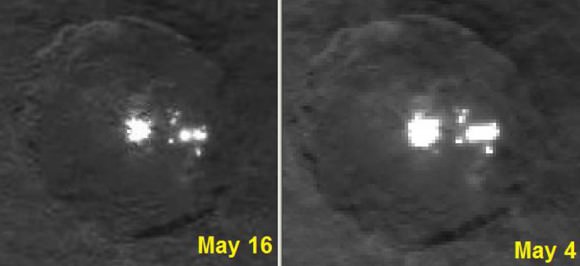
The latest photo is part of a sequence of images shot for navigation purposes on May 16, when the spacecraft orbited 4,500 miles (7,200 km) over the dwarf planet. Of special interest are a series of troughs or cracks in Ceres crust that appear on either side of the crater housing the spots.
While the exact nature of the spots continues to baffle scientists, Christopher Russell, principal investigator for the Dawn mission, has narrowed the possibilities: “Dawn scientists can now conclude that the intense brightness of these spots is due to the reflection of sunlight by highly reflective material on the surface, possibly ice.”
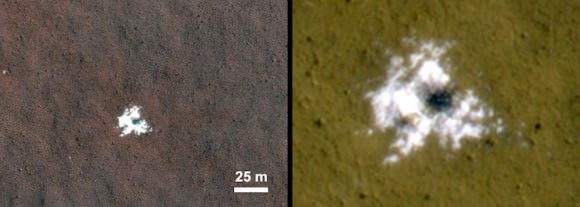
We’ve seen ice exposed by meteorite / asteroid impact before on Mars where recent impacts have exposed fresh ice below the surface long hidden by dust. In most cases the ice gradually sublimates away or covered by dust over time. But if Ceres’ white spots are ice, then we can reasonably assume they must be relatively new features otherwise they would have vaporized or sublimated into space like the Martian variety.
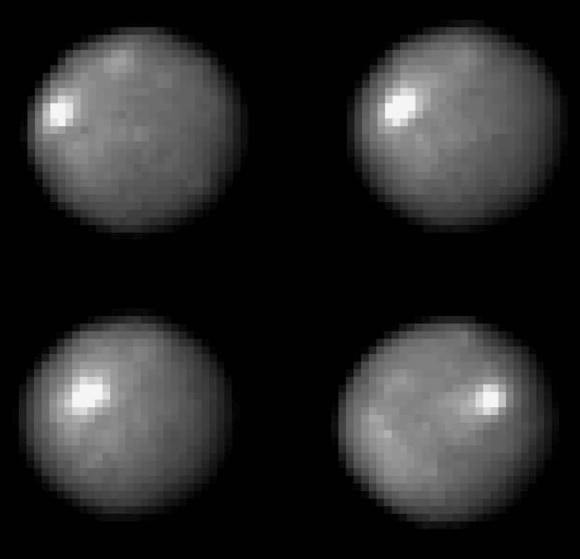
Much has been written – including here – that these spots are the same as those photographed in much lower resolution by the Hubble Space Telescope in 2004. But according the Phil Plait, who writes the Bad Astronomy blog, that’s false. He spoke to Joe Parker, who was part of the team that made the 2004 photos, and Parker says the Dawn spots and Hubble spots are not the same.
Could the spots have formed post-2004 or were they simply too small for Hubble to resolve them? That seems unlikely. The chances are slim we’d just happen to be there shortly after such a rare event occurred? And what happened to Hubble’s spot – did it sublimate away?
Video compiled from Dawn’s still frames of Ceres by Tom Ruen. Watch as the spots continue to reflect light even at local sunset.
Watching the still images of Ceres during rotation, it’s clear that sunlight still reflects from the spots when the crater fills with shadow at sunset and sunrise. This implies they’re elevated, and as far as I can tell from the sunrise photo (see below), the brightest spots appear to shine from along the the side of a hill or mountain. Could we be seeing relatively fresh ice or salts after recent landslides related to impact or tectonic forces exposed them to view?
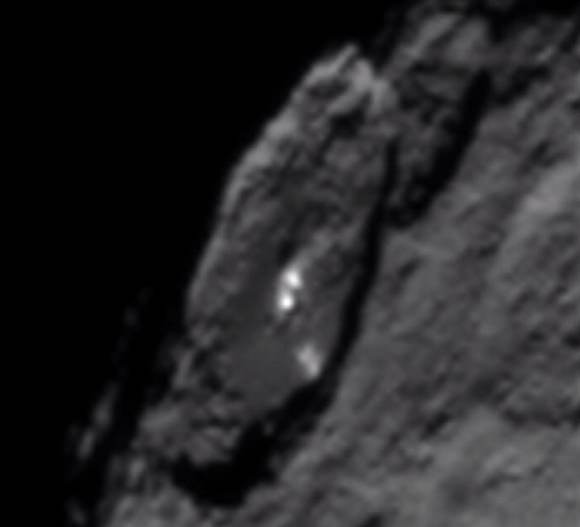
Let’s visit another place in the Solar System with an enigmatic white spot, or should I say, white arc. It’s Wunda Crater on Uranus’ crater-blasted moon Umbriel. The 131-mile-wide crater, situated on the moon’s equator, is named for Wunda, a dark spirit in Aboriginal mythology. But on its floor is a bright feature about 6 miles (10 km) wide. We still don’t know what that one is either!
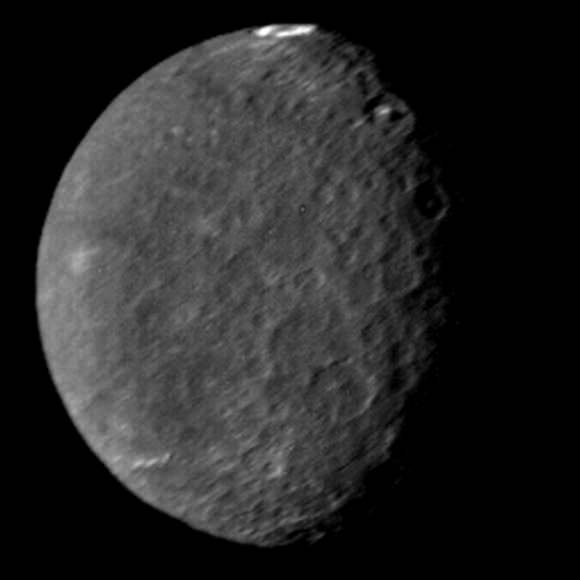

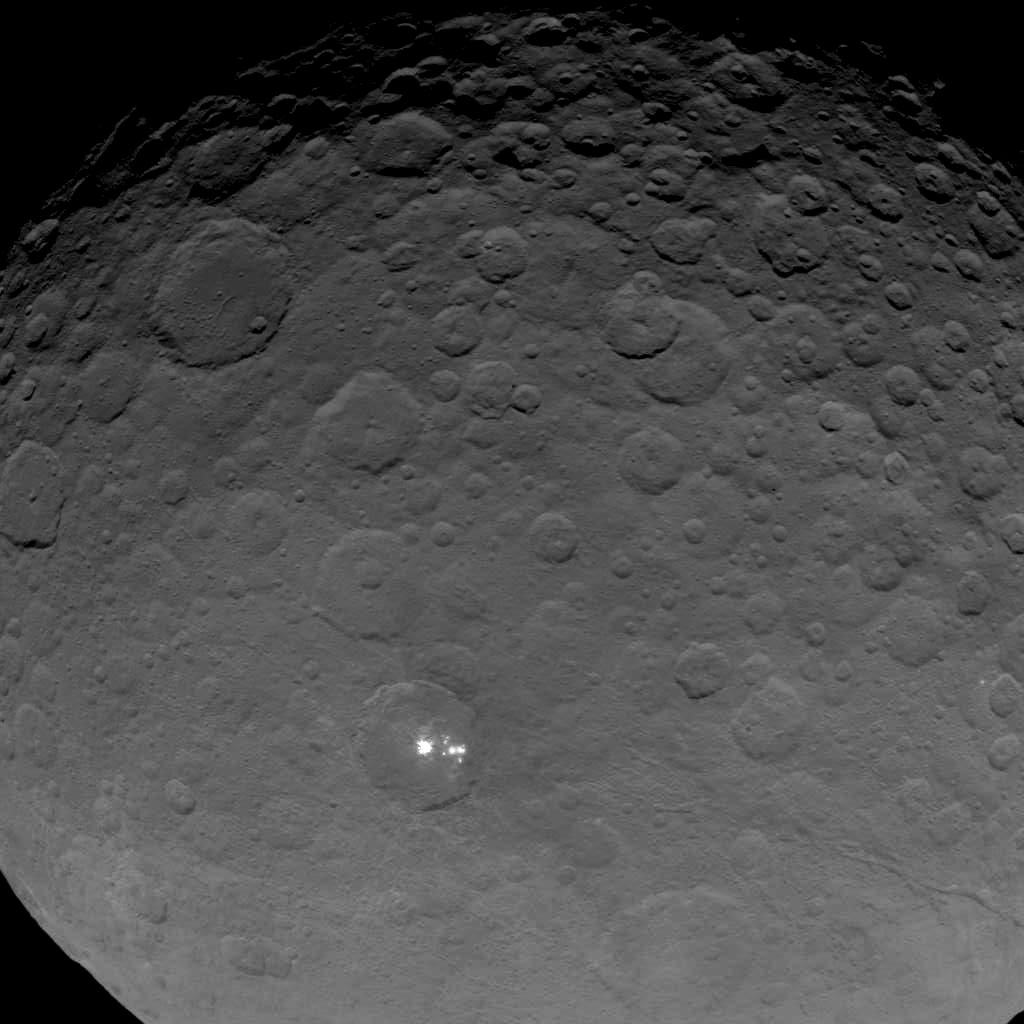
I asked this on an earlier comment but haven’t seen a response from anyone – could the surface be moving around at all like the surface of Titan seems to? I don’t mean like Europa – abviously we’re not seeing vast terrain changes and massive cracking and resurfacing – but is the surface overall drifting any? Could that be why the old bright spots not be “right” – because they’ve moved allot?
Though i suppose seeing them as short term features is more likely…
Hi Steven,
I think it’s too early to tell but an interesting thought.
🙂
I thought so too.
Obviously an impactor hit at an angle. That still caused a circular crater because of the surface impact friction. It melted and dug up underground ice at ground zero which caused the central white spot. But the impact pushed on through the subsurface in its direction, and created the elongated features along the one line from the center along which the subsurface was excited and the surface weakened. Volatiles boiling from the heat and penetrating the surface.
Why do real scientists even care, when the answer is available here from us, the anonymous responsible commentators? We’re cheaper anyway. (I hope you all understand that I am joking here)
Interesting is how recently something like this could’ve happened.
FarAway,
Whether or not someone correctly guesses the nature of the spots, what I enjoy about our “anonymous commentators” is the range of ideas offered. Even if all the suggestions turn out to be incorrect in the end, the comments the mental juices flowing.
Comet science is trivial, anyone can do it. I’m actually made up of comets myself, so I’m born with insider information. :-p
Great post Bob! Very interesting to see the comparison images of ice on Mars. The Mars ice spot being,… what? 100 ft. across? On Ceres it is,… what? 6 miles? I am wondering, is it possible for crystals to form or perhaps collide gently with Ceres? Do large crystals exist free floating in space?
QubitsToy,
There may be ice crystals out there where Ceres orbits (perhaps shed by comets) but they would be small, few and far between. Then you have to ask why they would only “paint” one small area of Ceres instead of being more evenly distributed around the globe.
of course, that’s assuming that the crystals are made from water
😉
How rare are impacts on Ceres? I see no evidence (with my limited opportunities) of partially sublimated areas. The surface color at this distance seems quite uniform.
ggregory,
Impacts still must happen at Ceres as they continue to do at Mars, the Moon and of course the Earth. We don’t know what the cratering rate is at Ceres, but Mars, which is closer to the asteroid belt than Earth, gets whacked by some 200 asteroid impacts a year according to a recent study. Our orbiting probes have identified around 250 new impact craters there; most of them are around 13 feet across.
My guess is that it’s a result of a shallow angle impact by a rock from the left to the right which just grazed the top of the central crater peak thus causing a landslide and excavating the big roundish splotch of ice and buried itself in the long feature on the right. It’s either that or the landing pad for my spaceship with the lights still on 🙂
Ok, here’s my guess: It’s ice being pushed up from the interior due to some sort of volcanism. Here’s why I think so.
1) If the bright spots were caused by landslides, they would be all over Ceres instead of just a few sparse locations.
2) The bright spots are associated with craters, where material has been dug out and the crust is thinner and weaker. It’s easier for an ice volcano to form there, I would think.
3) In the clip showing the effect of rotation on the view of the spots, one can see “rims” on the edge of them, showing elevation as Bob has already pointed out. This looks to me like edges of volcano cones.
We’ll see the answer in a few short weeks!
Could the Hubble images have shown the result of a recent asteroid, comet or meteor impact? Or perhaps there was even a cryogenic volcano eruption? Was that bright smudge Hubble saw an expanding cloud of vapors and dust reflecting so brightly then dissipating? Has the location of that ‘cloud’ been pinpointed and thoroughly investigated to look for evidence of a ‘new’ crater or large vent?
WHAT the heck are those new bright spots? Don’t you just love a mystery?
I’m not an expert at all, but my guess is that the reason of the bright spots is a kind of phosphorescence on Ceres.
(Some glow-in-the-dark material is releasing the absorbed sunlight energy slowly in this case?).
As the light intensity seems quite unchanging on the videos – while Ceres is rotating – I would not think it’s the reflected sun light on ice, salt or other surface materials. On the dark side of the object I didn’t see bright spots, so I would also exclude the volcanoes as reason.
I agree with albaka, luminesce or phosphoresce looks like a strong possibility, short of a mining camp.
Although I will admit, the side shot is convincing. Showing what looks like a landslide on the side of the mountain peak in the center of the crater, fits the fact that telescope based photos located this type of bright spot at a different location back in 2004? The crust could break open exposing ice across huge distances. It would happen randomly in various places, at different times. A different spot 10 years ago than today. There are other bright spots all around Ceres.
The plot thickens, Another great follow-up by Bob, This is a great time to be alive, We all stand on the shoulders of Giants and I wish they could be here to see these great images, If you look closely on the right side of the main mountain peak there is a dark spot that looks like Mist or Vapour I see 4 of these (Vents) in the area of (the ice) I think there is some type of Venting going on that is then collecting into Ice Areas either way this is Fantastic and we are all loving this Great Mystery…Thanks Bob!
Perhaps a better question might be, why is the albedo of Ceres so uniformly drab with just these few bright exceptions?
“Scientists with the Dawn mission believe they’re highly reflective material, likely ice” ……Do ice on Earth reflect that brighter from ISS?
instead of focusing on the bright spot …
– the crater seems devoid of smaller impactors
– the crater to the NNW seems a twin, except for the bright spots
– the crater seems fuzier than its NNW twin
– the crater central peek has rilled sides.
– Other (older?) deeper craters don’t show bright spots
– Planet troughs/cracks do not continue through the crater, but follow the south rim
Conclusion: aliens … ooops … I mean.
=> A once water filled basin with a saltwater vulcano, where a form of deposit at active vents has a white look … fresh salt deposit after sublimation? … (Ceres salt for your breakfast egg? 5 euro for a small shaker?)
I noticed on the first image in the series as above the one central spot is split into two and than on the last image in the movie as the crater is going to disappear that brightness ends but the peaks of the central area are still to me visible – about the 9th second into the movie. This implies one side of the peak being reflective. Perhaps the whole subsurface is ice mostly covered in dust meters thick or so and a double landslide exposed one side of the peak and perhaps the same quake caused some exposures in the secondary right spot complex.
Which brings up the question of quakes. The Moon has had some bigger quakes – a 5.5 mentioned here – http://solarsystem.nasa.gov/scitech/display.cfm?ST_ID=1149
So… could it be similar on Ceres?
Steven and everyone,
Really have enjoyed reading your comments. Thanks all for participating in the discussion.
We need a REAL expert’s analysis… Someone get Dick Hoagland on the horn!
It might be worth mentioning another place where there’s a bright reflective feature on an otherwise dark surface – at the north pole of Umbriel.
Duncan,
That’s right! I’d completely forgotten about that. Can’t remember the last time I looked at photos of Umbriel. I’m so glad you brought it up. I think I’ll include the image right now. Cheers!
Duncan Lunan, The bright reflective circle on Umbriel is Not on the North Pole it is in fact in the Wunda crater which is on the Equator.. It does look like its on the North Pole but its not because Umbriel orbits on her Side ( probably because of the many impacts she has taken)…
I believe the bright spots on Ceres are electrical discharges. That would explain the self illumination, the varying brightness that has been reported, and the apparent vertical component. If the electrical theory is right, then a testable hypothesis will be that the bright spots move and change shape. We will see…